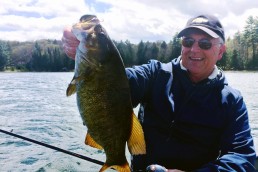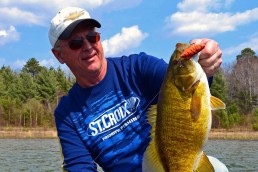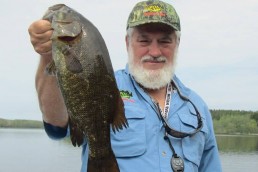Pre-spawn Crappie Techniques to Improve Catch
SHARE THIS POST
Pre-spawn is simply a period of time before the spawn. The middle states should be in the pre-spawn period while the northern states are about a month away. The timing is primarily based upon water temperatures, so late winter and early spring warming and cooling trends can change pre-spawn and spawn dates.
Pre-spawn
Warming waters bring crappies up into the creeks and into the coves, but not up in spawning sites. Fish are actively feeding and preparing for their spring ritual. The depth of the fish varies with the overall water depth, clarity and type of lake. Where you find crappies in a deep, clear lake will be different than in a shallower, dingy water lake. However, one constant is that the majority of the fish will be holding in areas where spawning banks are easily accessible.
Techniques can vary during the spawn. Dingy waters are prime for jigging or slow trolling. Slightly stained waters can be fished with almost any technique. Clearer lakes are ideal for casting. In all but a few of the most stumpy or vegetation-choked lakes, casting will work.
One key for pre-spawn is not to get suckered into the bank when the majority of fish are still out in the holding areas. The females are the last to go in. To catch the females it’s best to stick with holding areas until the spawn is in progress.
Casting tactics
Two classic ways to cast are free-fall and with a float. A free-fall jig is great when fish are 4 to 12 feet deep. The fish may be near a weedline, drop-off or other type of structure.
Casting to bottom-hugging fish means casting the jig, letting it drop to the bottom, and then working it back to the boat. A popular presentation is a hop caused by popping the rod tip. It is followed by a pause while the line is taken up and the rod tip dropped. The hop-pause is repeated. Experimenting with different hops—from a slight twitch, to a one-foot hop—will let you know which one the crappies prefer. A bonus of the hop-pause is that fish usually hit on the drop, so when the hop is made it sets the hook on the fish or at least gives the indication of the bite.
Cover sometimes prevents working a jig on the bottom, or the fish are suspended up higher. One method for getting to the right depth is the countdown method. For example, if the depth is 11 feet and you want your jig at 8 feet, count, “One thousand one, one thousand two…” and so on, until you get to a count of one thousand eight, then retrieve. A rule of thumb is that it drops one foot per second. However, line diameter, jig weight and body size all play a role in the rate of fall. So counting down to one thousand eight would put the jig at approximately 8 feet. Trying different counts will quickly let you know the right count, so the jig will stay above the cover and be in the strike zone.
When fish are in the upper part of the water column, it’s a good time to lighten the jig weight. A lighter jig, like a 1/32- or 1/48-ounce jig, lets a fisherman maintain a slow retrieve without the jig falling into deeper water. The negative factor for lighter jigs is wind and casting distance. Wind will making casting difficult and put a bow in the line making strikes difficult to detect.
Are you enjoying this post?
You can be among the first to get the latest info on where to go, what to use and how to use it!
Most experts recommend retying a few times each trip. Line can get abrasions and become week. The knot can get weak. Cut off a foot or two of line and tie the jig back on.
Floats
Whether you call them floats, floaters, corks, bobbers or strike indicators, a float keeps the bait at a constant depth and allows the bait to be stopped. A deadly combo is a minnow under a float. However, since we are discussing casting, and minnows don’t hold up to constant casting, we’ll stick to a float and jig.
A jig and fixed float is good when fishing shallow. A fixed float keeps the jig in direct contact and it can be pulled with a faster retrieve without the jig pulling up through the float. A small, weighted Styrofoam or plastic float are good picks.
A slip float can be fished any depth. An advantage is longer casts because the float rest against the jig until it hits the water. Quick depth changes can be made by sliding a bobber stop up or down the line to set proper depth.
Pre-spawn fish may prefer very slow actions. A small wiggle-wiggle-pause might be all that’s required under a float. More aggressive fish might prefer a steady, slow retrieve, a constant twitch and slow retrieve, or a pulling of the float about two feet and then pause. There are no perfect actions that work all the time so testing different ones will entice more fish and let you know the best retrieve at that particular time.
Pre-spawn fishing can be some of the best big-fish action of the year. Many techniques work to catch them but casting is fun, simple and productive.
Final tip
A critical factor to enjoy a trip is to stay warm during early-season cold fronts. A fisherman must be comfortable to stay out and concentrate on fishing. Just because it’s early spring doesn’t mean it’s warm. Wear layers of clothes and plenty of them. It’s easier to shed layers if you get warm.
MWO
SHARE THIS POST
Did you enjoy this post?
You can be among the first to get the latest info on where to go, what to use and how to use it!
Tim Huffman
Tim Huffman specializes in crappie fishing, is editor for two crappie magazines, as well as writing for several others. In 2018, he published his sixth book, Limiting Out for Crappie, available at Amazon. His first article appeared in MidWest Outdoors in 1988.



